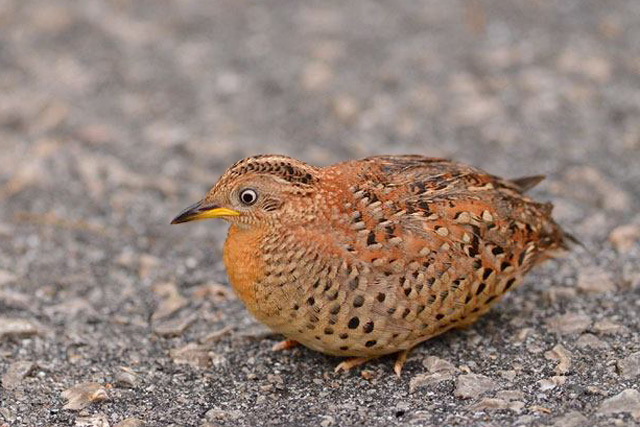
Turnix tanki
TAXONOMY
Turnix tanki Blyth, 1843, Bengal. Two subspecies recognized.
Possibly related to the spotted buttonquail T. ocellata, a littleknown
Philippine endemic.
OTHER COMMON NAMES
French: Turnix indien; German: Rotnacken-Laufhьhnchen;
Spanish: Torillo Tanki.
PHYSICAL CHARACTERISTICS
6.7 in (17 cm); male 1.2–2.6 oz (35–78 g), female 3.3–4 oz
(93–113 g). Rather large buttonquail, grayish with dorsal barring,
a pale boldly spotted underside, and yellow bill and legs.
Female more brightly colored, with reddish collar. Juvenile
smaller, mottled red, and densely spotted.
DISTRIBUTION
T. t. tanki: India, Pakistan, Andaman and Nicobar islands; T. t.
blanfordii: Myanmar through Indochina and eastern China,
north to Korea, south Amurland, and Ussuriland.
HABITAT
Grassland, farmland, secondary growth on abandoned cropland,
grass beneath bamboo thickets, and scrub.
BEHAVIOR
Terrestrial, diurnal, and partly nocturnal. Migrates at night.
FEEDING ECOLOGY AND DIET
Eats seeds, green shoots, and invertebrates obtained from the
ground. Mostly granivorous.
REPRODUCTIVE BIOLOGY
Lays from March to November and sometimes in other months,
though usually in the rainy season from June to October. Females
are sequentially polyandrous. Clutch is usually of four
eggs, incubated for 12 days. Chicks can fly at 10 days and acquire
adult plumage by seven weeks.
CONSERVATION STATUS
Not threatened. Poorly known, but apparently widespread and
common.
SIGNIFICANCE TO HUMANS
Hunted for food.
Other popular Animals
Photo Gallery of - Yellow-legged buttonquail




 Animalia Life
Animalia Life